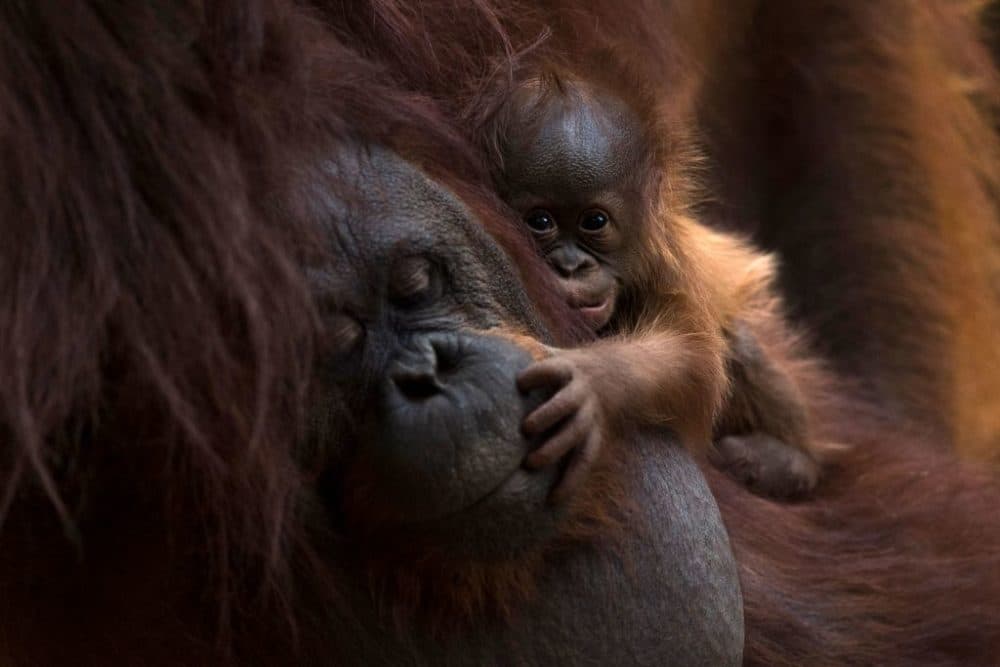Advertisement
In 'An Immense World,' Journalist Ed Yong helps us perceive the world the way animals do

While you read these words, countless treehopper insects on a branch somewhere in the Panamanian rainforest are listening to one another.
They can’t hear us, and — normally — we can’t hear them.
We both inhabit the same physical world, but our sensory worlds could not be more different.
As Marcel Proust put it:
The only true voyage would be not to visit strange lands, but to possess other eyes. To see the hundred universes that each of them sees.
Today, On Point: That is the voyage science writer Ed Yong hopes to take us on in his new book, An Immense World.
Guests
Ed Yong, staff science writer at The Atlantic, where he won the 2021 Pulitzer in explanatory reporting for his work on the COVID-19 pandemic. Author of An Immense World: How Animal Senses Reveal the Hidden Realms Around Us. (@edyong209)
Professor Rex Cocroft, professor of biology at the University of Missouri.
Transcript: Soundscapes From The Insect World
What if you could taste the world’s electrical fields? Hear vibrations in a leaf? See magnetic currents guiding you home? Or even imagine yourself inside the body of another creature? In a new book, author Ed Yong helps us perceive the world the way animals do.
"My goal as a writer here ... is to get people as close to the edge as possible, so that they can sort of peer over the other side, and think about how they might actually make that final jump. I think it is possible.
And there's something glorious about attempting a task that you know you won't succeed in, but you're going to give it a shot anyway. That's what it feels like to me to think about these sensory worlds."
So how can humans go through the exercise of imagining what it's like to be another creature?
To answer that question, Ed profiles the work of researcher Rex Cocroft. He's a professor of biology at the University of Missouri, and he studies a family of insects called treehoppers.
Below, find soundscapes Professor Cocroft collected from the insect world:
Audio Highlights
MEGHNA CHAKRABARTI: Let's move over to the insect world for a moment and listen to this.
So that is a recording of the mating songs of leafhoppers. And it comes to us from one of the many wonderful scientists that Ed Yong profiles and encounters in [his] book An Immense World.
And that scientist is Rex Cocroft. He's professor of biology at the University of Missouri. And he records things like … the sounds of insects on plants, particularly the sound of a family of insects called treehoppers. Professor Cocroft has been studying them for nearly 30 years. ... Professor Cocroft, welcome to On Point.
REX COCROFT: Thank you. It's a pleasure.
CHAKRABARTI: Tell us a little bit about what we're hearing.
COCROFT: Well, we're hearing the sounds of these little insects that spend their lives on plants. They feed on plant sap. And they're very small. They're not very good at producing sounds that would radiate in the air. But plants are really exquisite structures for transmitting vibrations. Anything that really touches the plant will create a vibration, a wave that spreads through the plant.
Advertisement
And so they have evolved ways to introduce or inject vibrations into those plants. And then the vibrations just naturally and very quickly travel throughout part or most of the plant. And then other insects have these arrays of exquisite vibration detectors in their legs that they use to pick them up.
CHAKRABARTI: I see. So what do treehoppers look like, for those of us who haven't seen this family of insect before?
COCROFT: Well, this whole group of insects in German are called small cicadas. And essentially their body looks exactly like a miniature cicada. But the interesting thing about treehoppers is that part of the structure on their back has become very exaggerated for reasons that nobody really understands. But it forms kind of strange shapes that sometimes look like the Starship Enterprise coming out of their back.
CHAKRABARTI: So let's listen to another little example of sound, Professor Cocroft, that you so kindly gave to us. Mainly, this is a demonstration of how there are sound in places where we as humans think are usually totally silent.
What was that?
COCROFT: So that is the soundscape of a single blade of grass, recorded not far from my house in Missouri. And that's just one example. I could have given you hundreds of examples, but I picked that one partly because it shows how our world inner penetrates with theirs. And how sound and vibration can be kind of interchanged. Because somebody who is familiar with backyard birds might have noticed that they could hear the sound of a Carolina wren in the background.
And plants are very good absorbers of airborne sound, and so an insect's vibrational world on a leaf includes all those interesting vibrational signals that they produce. And we heard the songs of leafhoppers. Those were male leafhoppers looking for a mate. But it also includes all the airborne sounds that we hear. And so they are not part of our sensory world, but we are part of their sensory world, because they live on these structures that pick up sounds and turn them into vibration.
CHAKRABARTI: What kind of impact have you observed of human beings being part of the sensory environment of the treehopper family of insects?
COCROFT: Well, we really are unaware of what a commotion we make when we simply brush past a plant. If there's a family of treehoppers on that plant, they will be communicating about you for five or 10 minutes after you pass, whereas you're completely unaware of them. And so any anything that we do while we're moving around and of course, all of our equipment and vehicles that are producing sound or vibration are also picked up, and now have become part of their sensory world as well.
CHAKRABARTI: Well, let's play another bit of sound recording that you've made in the field, professor. This is, again, the treehoppers. And they're not at all what we maybe typically presume insects are supposed to sound like. This sounds almost like a synchronized mooing.
COCROFT: That's a perfect description. And I included this one because it shows how these insects ... live in groups and they can use these signals or these sounds to cooperate with each other. And what you heard was exactly a synchronized set of moos from some individuals that were already in a group, and then immediately afterward some running footsteps of other insects that were searching for that group. And using those synchronized moos to locate the group.
CHAKRABARTI: … Here's another [piece of sound]. So, Professor Cocroft, this one's a little bit different. It's a caterpillar eating a leaf. What should we discern or glean from that sound?
COCROFT: Well, this actually takes us a little bit beyond Ed's book, wonderful as it is. Because for a long time those of us that studied vibrations traveling through plants, didn't really think about the fact that these were traveling through a living organism that is itself exquisitely sensitive to vibration, which plants are. And it was only fairly recently that I and my collaborator, Dr. Heidi Appel, at the University of Toledo, thought about the question of whether some of this information that's traveling through the plant could be useful to the plant.
And where I thought we should start is with those munching sounds of a caterpillar feeding on a leaf. And caterpillars can't avoid making those sounds. They scrape off a little bit of tissue, swallow it without any further chewing. Scrape off another. Scrape off another. And they can't help but producing tons of vibration within the leaf.
So in thinking about signals or cues that animal's produce, and how this relates to their interactions with other species, we need to think about how their predators might sense them. And so insects' predators can home in on those vibrations.
But we also need to think about how their prey — in this case, the plant — might also react to it. And what we found is that plants actually react to that munching sound by producing more chemical defenses that protect them against caterpillars.
CHAKRABARTI: Oh, fascinating. ... I'm quite inspired by what Ed asks us to do as humans throughout his book. And I wonder if you, in your daily work, ever do this. And that is wonder or try to imagine yourself into what it would be like to be, you know, a treehopper? Or a specifically, a leaf hopper insect. Is that an exercise that you've ever gone through or wondered about?
COCROFT: Absolutely. I think that's actually an essential research skill, because the first thing that I would encourage a student to do, if they're studying one of these creatures, is to go and sit under a bush and just listen and try to put themselves into the world. And suddenly you will begin to see some aspects of that world from the insect perspective. What is a tiny insect in a huge world?
And oh, it's windy now. ... And you just suddenly begin to develop questions about what that insects' experience is like. And I'll say that one of the really wonderful things about studying this vibration, this vibrational modality, is that actually with the aid of a little bit of technology and increasingly cheap technology, we can actually bridge that sensory gap and enter into their world.
And so you might ask, Well, how are we hearing something that's only traveling through the leaf? But with a whole variety of different kinds of vibration sensors, we can actually turn that into sound, and experiencing it using one of our own very well-developed senses. And these worlds of sound within plants are so alien to us that they're really kind of an aesthetic delight.
Related Reading
New York Times: "How Animals See Themselves" — "Spectacle floods into my eyes whenever I watch a wildlife documentary. A vortex of small fish is gradually picked off by waves of oceanic predators. Snakes chase after marine iguanas. Giraffes clash at sunset."
This program aired on June 28, 2022.

